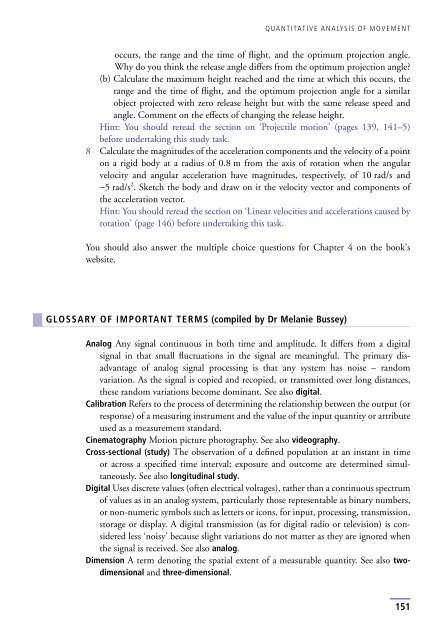Introduction to Sports Biomechanics: Analysing Human Movement ...
Introduction to Sports Biomechanics: Analysing Human Movement ...
Introduction to Sports Biomechanics: Analysing Human Movement ...
Create successful ePaper yourself
Turn your PDF publications into a flip-book with our unique Google optimized e-Paper software.
QUANTITATIVE ANALYSIS OF MOVEMENT<br />
occurs, the range and the time of flight, and the optimum projection angle.<br />
Why do you think the release angle differs from the optimum projection angle?<br />
(b) Calculate the maximum height reached and the time at which this occurs, the<br />
range and the time of flight, and the optimum projection angle for a similar<br />
object projected with zero release height but with the same release speed and<br />
angle. Comment on the effects of changing the release height.<br />
Hint: You should reread the section on ‘Projectile motion’ (pages 139, 141–5)<br />
before undertaking this study task.<br />
8 Calculate the magnitudes of the acceleration components and the velocity of a point<br />
on a rigid body at a radius of 0.8 m from the axis of rotation when the angular<br />
velocity and angular acceleration have magnitudes, respectively, of 10 rad/s and<br />
−5 rad/s 2 . Sketch the body and draw on it the velocity vec<strong>to</strong>r and components of<br />
the acceleration vec<strong>to</strong>r.<br />
Hint: You should reread the section on ‘Linear velocities and accelerations caused by<br />
rotation’ (page 146) before undertaking this task.<br />
You should also answer the multiple choice questions for Chapter 4 on the book’s<br />
website.<br />
GLOSSARY OF IMPORTANT TERMS (compiled by Dr Melanie Bussey)<br />
Analog Any signal continuous in both time and amplitude. It differs from a digital<br />
signal in that small fluctuations in the signal are meaningful. The primary disadvantage<br />
of analog signal processing is that any system has noise – random<br />
variation. As the signal is copied and recopied, or transmitted over long distances,<br />
these random variations become dominant. See also digital.<br />
Calibration Refers <strong>to</strong> the process of determining the relationship between the output (or<br />
response) of a measuring instrument and the value of the input quantity or attribute<br />
used as a measurement standard.<br />
Cinema<strong>to</strong>graphy Motion picture pho<strong>to</strong>graphy. See also videography.<br />
Cross-sectional (study) The observation of a defined population at an instant in time<br />
or across a specified time interval; exposure and outcome are determined simultaneously.<br />
See also longitudinal study.<br />
Digital Uses discrete values (often electrical voltages), rather than a continuous spectrum<br />
of values as in an analog system, particularly those representable as binary numbers,<br />
or non-numeric symbols such as letters or icons, for input, processing, transmission,<br />
s<strong>to</strong>rage or display. A digital transmission (as for digital radio or television) is considered<br />
less ‘noisy’ because slight variations do not matter as they are ignored when<br />
the signal is received. See also analog.<br />
Dimension A term denoting the spatial extent of a measurable quantity. See also twodimensional<br />
and three-dimensional.<br />
151






